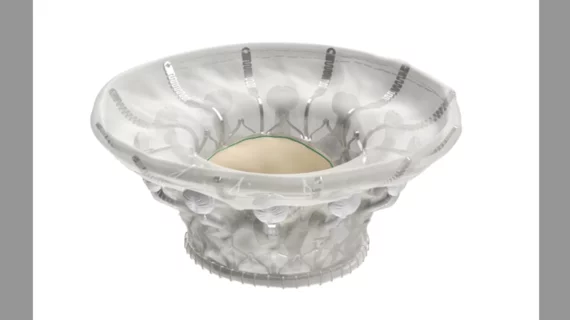Cardiologists first in world to use new heart valve for TMVR, TTVR on same patient
Cardiologists in Germany have successfully performed transcatheter mitral valve replacement (TMVR) and transcatheter tricuspid valve replacement (TTVR) on a single patient with the same prosthesis, sharing their experience in European Heart Journal—Case Reports.[1] The two procedures occurred within 18 months of one another.
The patient in question was a 78-year-old male with heart failure, peripheral edema, severe mitral regurgitation and moderate tricuspid regurgitation (TR). He also presented with permanent atrial fibrillation, chronic kidney disease, type 2 diabetes and pulmonary hypertension. His left ventricular ejection fraction was 52% and Society of Thoracic Surgeons score was 16.7%.
The high-risk patient had previously undergone coronary artery bypass graft surgery at the age of 55.
First, lead author Tobias Schmidt, an interventional cardiologist with the University Hospital Schleswig-Holstein in Lübeck, Germany, and colleagues used the Cardiovalve implantation catheter system and Cardiovalve prosthesis to perform transfemoral TMVR. Echocardiography confirmed the procedure was a success, and the procedure was discharged to a rehab clinic after 11 days of observation. He was prescribed warfarin to prevent the formation of blood clots.
After 18 months, echocardiography showed that the moderate TR had progressed. The heart team then performed transfemoral TTVR. Again, the group used a Cardiovalve implantation catheter system and Cardiovalve prosthesis. The patient was discharged home after eight days of observation. He was prescribed warfarin once again.
Fluoroscopy of implantation of the Cardiovalve prosthesis in tricuspid position. (A) At baseline with only the Cardiovalve in mitral position (projection LAO 70°); (B) opening of the ventricular legs of the tricuspid Cardiovalve system (projection RAO 24°); (C) CardioTwins with Cardiovalve sitting in mitral and triscuspid position long axis view (projection RAO 20°); (D) CardioTwins with Cardiovalve sitting in mitral and triscuspid position short axis view (projection LAO 70°). Images/captions courtesy of European Heart Journal—Case Reports, Schmidt et al.
Nine months after the second procedure, follow-up imaging confirmed there were no signs of paravalvular leak in either prosthesis.
“There are different types of transcatheter prosthesis that can be implanted via a transfemoral–transseptal approach currently within early feasibility studies available,” the authors wrote. “One of these systems is the Cardiovalve prosthesis, which can be implanted in mitral but also in tricuspid position. The prosthesis consists of two elements for the anchoring mechanism; the ventricular legs are necessary to achieve the attachment with the leaflets from the ventricular side and an atrial flange to cover and anchor from the atrial side. In the middle of the device, the three-scallop-shaped bovine pericardial leaflets are sutured to function as a complete replaced valve. The two elements create 24 grasping points that fixate the device to the native tricuspid/mitral annulus.”
The group noted that this was the very first patient in the world to undergo both procedures with the same Cardiovalve system. Both procedures were performed as part of ongoing clinical trials.
In December 2021, Chinese-based Venus MedTech announced its acquisition of Israel-based Cardiovalve for approximately $300 million. Cardiovalve was founded by Amir Gross, a serial entrepreneur with years of experience in the cardiology space.
The Cardiovalve system is not yet approved by the U.S. Food and Drug Administration or other regulatory agencies for commercial use.
Click here to read the full analysis in European Heart Journal—Case Reports, a European Society of Cardiology journal.

![Cardiologists in Germany have successfully performed transcatheter mitral valve replacement (TMVR) and transcatheter tricuspid valve replacement (TTVR) on a single patient with the same prosthesis, sharing their experience in European Heart Journal—Case Reports.[1] The two procedures occurred within 18 months of one another. Cardiovalve.](/sites/default/files/styles/no_crop/public/2024-08/screenshot_2024-08-05_at_12.35.56_pm.png.webp?itok=KX-iyRT3)
